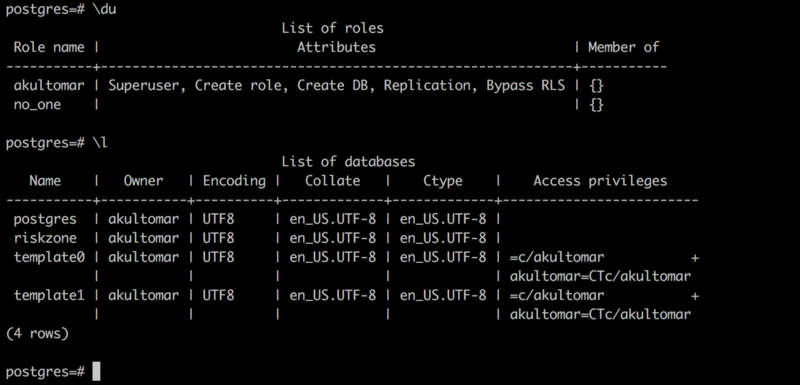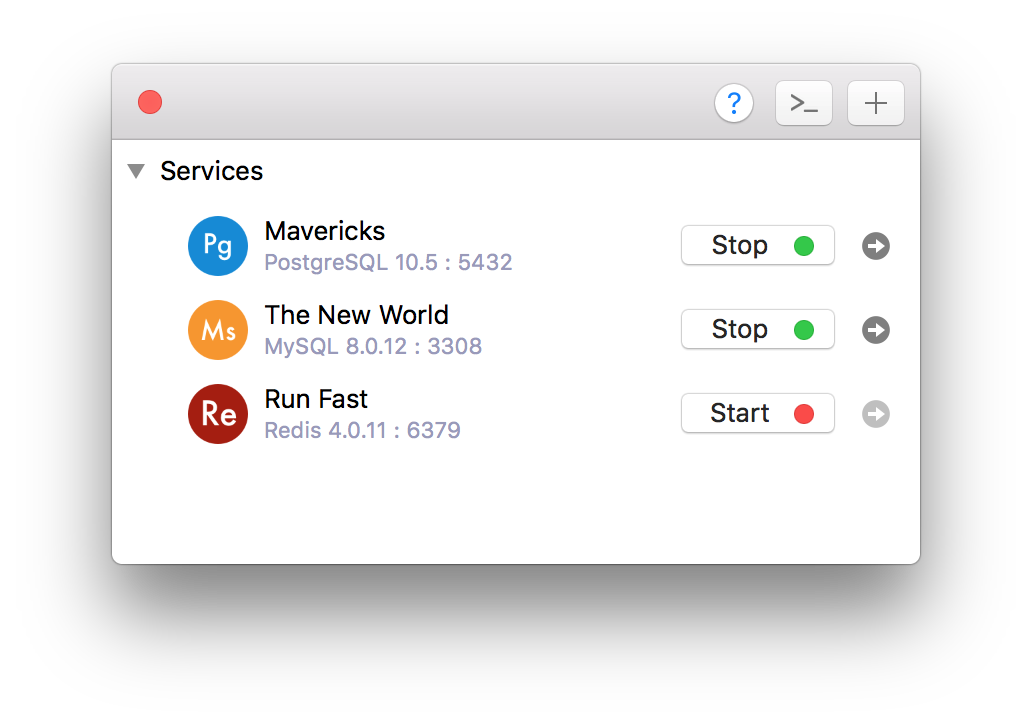This article was last updated on November 19, 2020
- Brew Services Start Postgresql Ubuntu
- Brew Postgresql Start Error
- Brew Services Start Postgresql Linux
This is a quick guide for installing PostgreSQL (Postgres for short) on a Mac with Homebrew, and starting and stopping it with Homebrew Services. If you're working on a Ruby on Rails project that requires Postgres, this tutorial will get you up and running in no time.
- Have you tried: brew services start postgresql? – Chessbrain Jul 16 '19 at 14:02 By logs provided by you i think you have delete pgtblspc and pgreplslot directory from data-diectory of postgresql 11.4 kindly put back those if you can't recover just create it using mkdir pgtblspc with postgres user permission and start again – Ashiq.
- Brew postgresql-upgrade-database This formula has created a default database cluster with: initdb -locale=C -E UTF-8 $(brew -prefix)/var/postgres.
The easiest way to install Homebrew, Postgres, and all the othertools necessary for Ruby on Rails development, is to run my free script that will set everything up for you.
If you prefer to do things manually and hope for the best, follow the steps below.

Install PostgreSQL brew install postgresql Start PostgreSQL brew services start postgresql Start PostgreSQL shell psql postgres Create User in PostgreSQL CREATE ROLE “express-mvp-dbuser” WITH LOGIN PASSWORD ‘123.456’. I would like to know correct way of starting/stopping postgres database. There are two ways pgctl start/stop service postgresql start/stop I would like to know how they are different from each o.
Step 1: Install Homebrew

Follow the instructions on their site.
Step 2: Update Homebrew
Before you install anything with Homebrew, you should always make sure it's up to date and that it's healthy:
Step 3: Install Postgres
When you install Postgres, Homebrew will provide useful information in your Terminal that you should read. Homebrew also helpfully creates a default database cluster. You can confirm that if you see the following output:
All the best Fashion Body Sketch 38+ collected on this page. Feel free to explore, study and enjoy paintings with PaintingValley.com. Sketches of body fashion. Apr 28, 2017 - Explore Mercedes Fisher-Mercado's board 'Fashion Sketches. , followed by 265 people on Pinterest. See more ideas about sketches, fashion sketches, body. Learn how to draw fashion figures in easy steps. Tutorials on how to draw the fashion body and create different model poses for your fashion sketches.
Step 5: Start the Postgres service
At this point, you should be all set to run the Rails commands to create and use the database in your app.
To stop Postgres:
To see a list of all services and their state:
Before anyone can access the database, you must start the database server. The database server program is called postgres. The postgres program must know where to find the data it is supposed to use. This is done with the -D option. Thus, the simplest way to start the server is:
which will leave the server running in the foreground. This must be done while logged into the PostgreSQL user account. Without -D, the server will try to use the data directory named by the environment variable PGDATA. If that variable is not provided either, it will fail.
Normally it is better to start postgres in the background. For this, use the usual Unix shell syntax:
It is important to store the server's stdout and stderr output somewhere, as shown above. It will help for auditing purposes and to diagnose problems. (See Section 23.3 for a more thorough discussion of log file handling.)
The postgres program also takes a number of other command-line options. For more information, see the postgres reference page and Chapter 18 below.
This shell syntax can get tedious quickly. Therefore the wrapper program pg_ctl is provided to simplify some tasks. For example:
will start the server in the background and put the output into the named log file. The -D option has the same meaning here as for postgres. pg_ctl is also capable of stopping the server.
Normally, you will want to start the database server when the computer boots. Autostart scripts are operating-system-specific. There are a few distributed with PostgreSQL in the contrib/start-scripts directory. Installing one will require root privileges.
Different systems have different conventions for starting up daemons at boot time. Many systems have a file /etc/rc.local or /etc/rc.d/rc.local. Others use init.d or rc.d directories. Whatever you do, the server must be run by the PostgreSQL user account and not by root or any other user. Therefore you probably should form your commands using su postgres -c '..'. For example:
Brew Services Start Postgresql Ubuntu
Here are a few more operating-system-specific suggestions. (In each case be sure to use the proper installation directory and user name where we show generic values.)
For FreeBSD, look at the file contrib/start-scripts/freebsd in the PostgreSQL source distribution.
On OpenBSD, add the following lines to the file /etc/rc.local:
On Linux systems either add
to /etc/rc.d/rc.local or /etc/rc.local or look at the file contrib/start-scripts/linux in the PostgreSQL source distribution.
On NetBSD, use either the FreeBSD or Linux start scripts, depending on preference.
On Solaris, create a file called /etc/init.d/postgresql that contains the following line:
Then, create a symbolic link to it in /etc/rc3.d as S99postgresql.
While the server is running, its PID is stored in the file postmaster.pid in the data directory. This is used to prevent multiple server instances from running in the same data directory and can also be used for shutting down the server.
17.3.1. Server Start-up Failures
There are several common reasons the server might fail to start. Check the server's log file, or start it by hand (without redirecting standard output or standard error) and see what error messages appear. Below we explain some of the most common error messages in more detail.
Brew Postgresql Start Error
This usually means just what it suggests: you tried to start another server on the same port where one is already running. However, if the kernel error message is not Address already in use or some variant of that, there might be a different problem. For example, trying to start a server on a reserved port number might draw something like:
A message like:

probably means your kernel's limit on the size of shared memory is smaller than the work area PostgreSQL is trying to create (4011376640 bytes in this example). Or it could mean that you do not have System-V-style shared memory support configured into your kernel at all. As a temporary workaround, you can try starting the server with a smaller-than-normal number of buffers (shared_buffers). You will eventually want to reconfigure your kernel to increase the allowed shared memory size. You might also see this message when trying to start multiple servers on the same machine, if their total space requested exceeds the kernel limit.

An error like:
does not mean you've run out of disk space. It means your kernel's limit on the number of System V semaphores is smaller than the number PostgreSQL wants to create. As above, you might be able to work around the problem by starting the server with a reduced number of allowed connections (max_connections), but you'll eventually want to increase the kernel limit.
Brew Services Start Postgresql Linux
If you get an 'illegal system call' error, it is likely that shared memory or semaphores are not supported in your kernel at all. In that case your only option is to reconfigure the kernel to enable these features.
Details about configuring System VIPC facilities are given in Section 17.4.1.
17.3.2. Client Connection Problems
Although the error conditions possible on the client side are quite varied and application-dependent, a few of them might be directly related to how the server was started. Conditions other than those shown below should be documented with the respective client application.

This is the generic 'I couldn't find a server to talk to' failure. It looks like the above when TCP/IP communication is attempted. A common mistake is to forget to configure the server to allow TCP/IP connections.
Alternatively, you'll get this when attempting Unix-domain socket communication to a local server:
The last line is useful in verifying that the client is trying to connect to the right place. If there is in fact no server running there, the kernel error message will typically be either Connection refused or No such file or directory, as illustrated. (It is important to realize that Connection refused in this context does not mean that the server got your connection request and rejected it. That case will produce a different message, as shown in Section 19.4.) Other error messages such as Connection timed out might indicate more fundamental problems, like lack of network connectivity.
